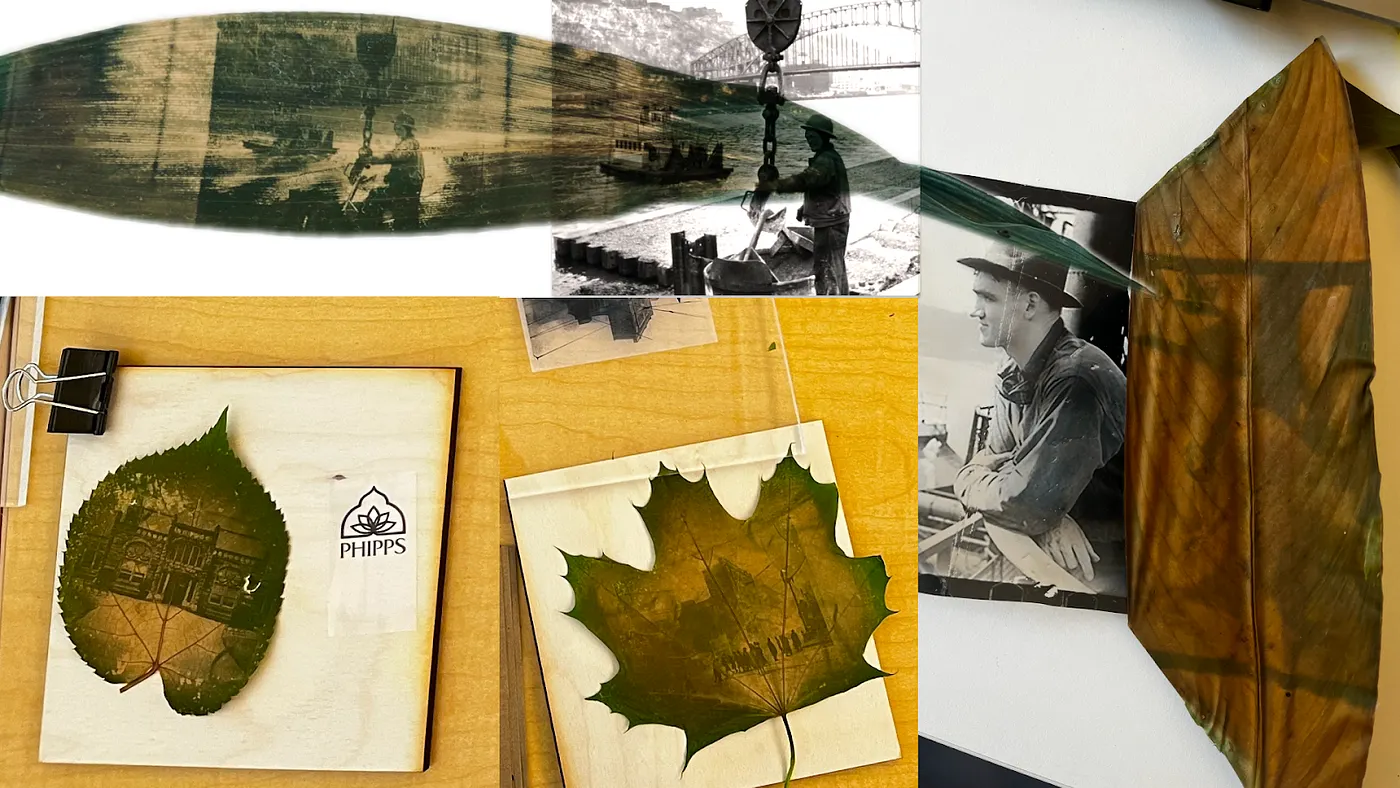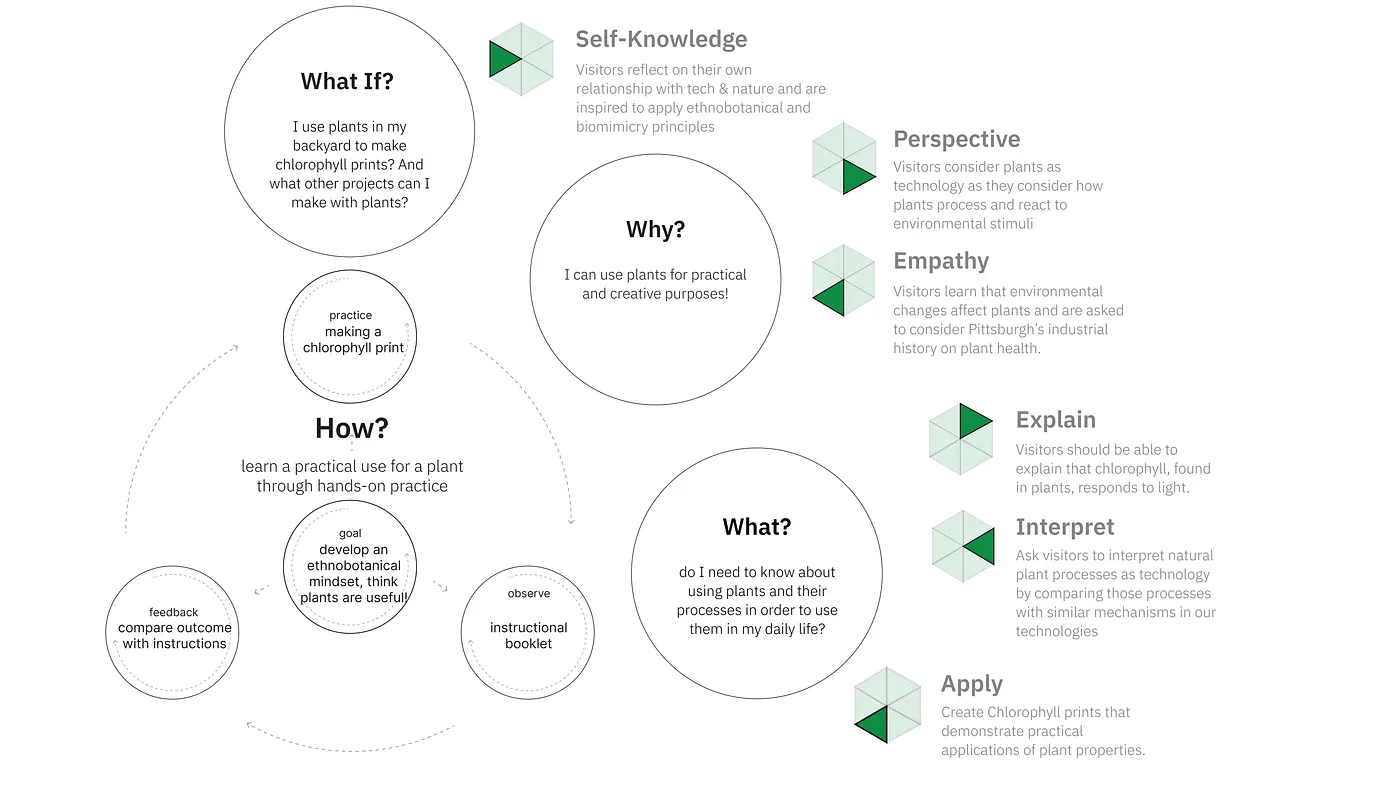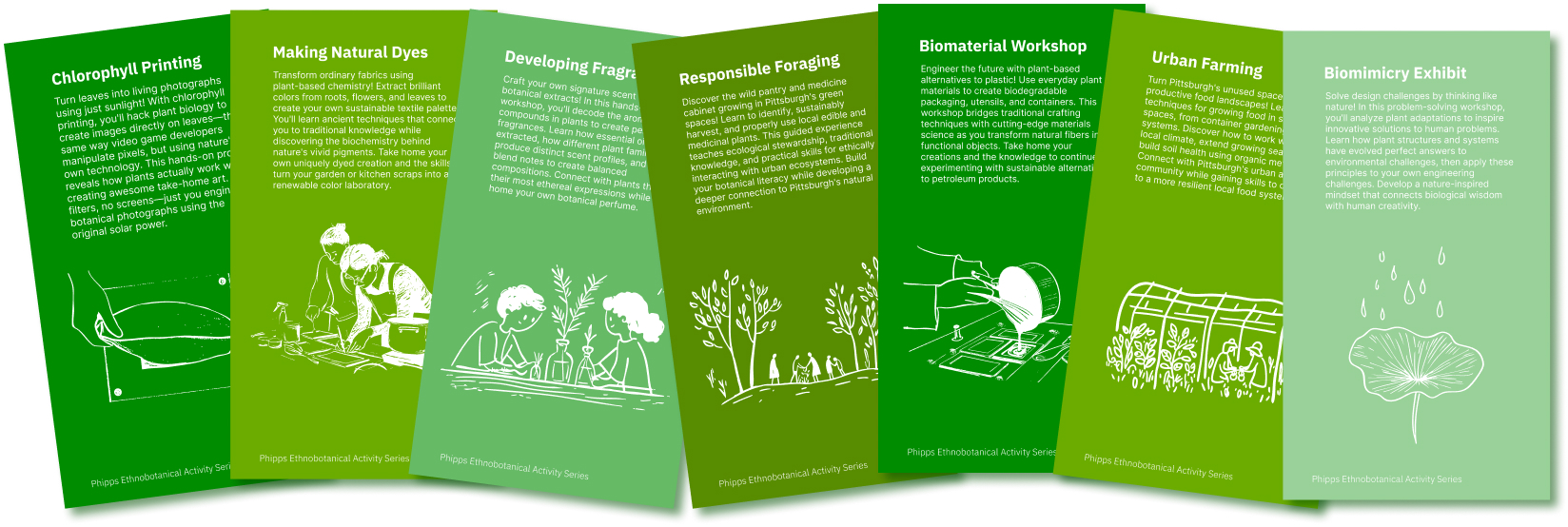Kimberly Blacutt,
Caitlyn Santiago, Nikita Valluri
Overview
Chlorophyll Printing: An active learning station and exhibition design for Phipps Conservatory that reimagines environmental learning at Phipps Conservatory by enabling young visitors (ages 15–30) to view plants as practical, technological tools through embodied, hands-on chlorophyll printing and other botanical crafts.
Outcome
On Final Showcase:
Hands-On Visitors
Deeply engaged in the chlorophyll printing activity.
Learning Impact
Explained how chlorophyll reacts to sunlight after participating.

The Problem
At Phipps Conservatory, many vistors come to admire the beautiful plant displays, but many leave unchanged. A 2024 survey revealed that 40% of visitors were unsure if they learned anything about sustainability, and 35% said their visit didn’t inspire any home improvements. Instead of sparking curiosity, Phipps often serves as a quiet retreat. This gap between beauty and learning limits Phipps’ mission to inspire and educate the public about sustainability, revealing an opportunity to transform passive appreciation into active engagement with nature.
Project Goals
- Connect Phipps Conservatory more closely to the city of Pittsburgh and its unique story.
- Engage young people, particularly those ages 15–30, as active participants in environmental education.
- Inspire all visitors to take meaningful actions as stewards of the environment.
Design Challenges
How might we?
- Design a more active and embodied learning experience that encourages and deepens understanding of plants’ biological and ecological roles
- Inspires visitors to take sustainable action
Research
To gain deeper insights into Phipps’ visitors and the challenges they face, our team conducted immersion sessions at Phipps, using a mix of observational and interview techniques to capture general visitor behavior. The map below offers a glimpse into the diverse behaviors we observed.
.png)
Notably, photography emerged as a popular activity among visitors. Our observations also confirmed our initial hypothesis about visitors’ limited understanding of Phipps’ broader mission, as reflected in comments like:
“It’s only pretty and peaceful, and quiet-that’s why I’m here.”
“There are just plants anyway-if you see one room, you’ve seen them all.”
Based on insights into how people perceive plants at Phipps, we decided to leverage their natural inclination toward photography. We set out to bridge sustainability and photography, while also celebrating Pittsburgh’s unique culture. When we discovered chlorophyll printing, we realized it was a perfect fit — not only is it far more eco-friendly than traditional printing and photography, using only natural leaves and sunlight with no chemicals, ink, or synthetic materials, but it also produces unique, one-of-a-kind images directly on plant material. This process minimizes environmental impact and fosters a deeper connection with nature.
Solution
We aim to teach visitors of Phipps’ how to practice plant and planet-friendly crafts by making chlorophyll prints. Photocopying doesn’t always involve a machine... sometimes all you need is a leaf, sunlight and a digital negative!
.png)
Process
Design Approach
Our design approach centers around reframing plants as living technologies through the hands-on process of chlorophyll printing, embedded within a broader Botanical Crafts Activity Series at Phipps Conservatory. We applied backward design and a custom learning cycle model to shape the entire visitor experience.
Conceptual Model: Our Learning Cycle Framework

Scenario Design
We mapped a realistic user journey to situate the activity in Phipps’ physical space:
We envision a special exhibit centered on Chlorophyll Printing at Phipps. This map shows the two key locations: a Chlorophyll Printing Station Notice in Palm Court, and the main Chlorophyll Prints Exhibit in the Serpentine Room.

As Visitors enter Phipps, they will see the sign located in Palm Court. This sign introduces our botanical craft Series and invites them to the Serpentine Room to see the Chlorophyll Prints Exhibit.
.png)
As visitors enter the Serpentine Room, they will see the active learning station for chlorophyll printing. This station allows them to apply your knowledge through hands-on practice. The interactive table offers materials like leaves, which are collected from Phipps, alongside Pittsburgh historical negative photos for prints.
This station provides learning through direct, hands-on practice, with Phipps staff giving live demonstrations and guidance throughout the chlorophyll printing process. We also envision having signs with chlorophyll prints along the pathway.
-min%202.png)
At the learning station, visitors have all the materials they need for chlorophyll printing. They first gather all the materials and set them up as shown. Then, they sandwich the leaf and place it in direct sunlight, waiting several days. Step 3 will not happen on the same day because it’s a process that takes time. Although visitors will not immediately see the result from their own leaf, they will be able to take leaves that other visitors have left behind if those visitors successfully set up more than one.

Besides the instructions, here are the DIY directions for visitors on where they can source materials, including where to get the transparency sheet, what types of leaves are recommended, and how to make a photo frame.
.png)
However, it might be hard for visitors to find the transparency sheet and photo frame on their own, even if they want to try it at home. To make it easier, we have created a take-home kit for visitors. The kit includes all the materials they need, so they don’t have to source everything themselves.
.png)
Booklet:
Key Learnings
.png)
1. Embrace the Unexpected Changes
We put so much effort into this project, but nature had its own timing. Pittsburgh’s unpredictable weather constantly tested our patience — on days we collected fresh leaves from Phipps, the sun would disappear, and the leaves would dry before absorbing any light. It was frustrating, yet it reminded us that designing with nature means adapting to its rhythms, not controlling them. Thankfully, as the weather warmed and days grew sunnier, we finally created our best prints just in time for the final presentation.
.png)
2. Collaboration Makes Ideas Bloom
I'm very grateful for the opportunity to collaborate with teammates from diverse backgrounds. Each person brought unique perspectives that shaped our process, transforming a simple idea into an experience that blended science, design, and storytelling. Their creativity and insight helped this project grow far beyond what I could have achieved alone, teaching me how diverse collaboration amplifies creativity and impact.
%20(1).png)
3. Designing for Creative Discovery
Through iterative prototyping and visitor interaction during our chlorophyll printing exhibit, we observed that participants were highly engaged by the tactile, self-guided experience. Visitors showed curiosity when comparing chlorophyll to photocopier technology, often expressing surprise that leaves could function as a medium for image-making. Feedback suggested that the conceptual reframing of plants as technology resonated most when paired with historical imagery of Pittsburgh, making the activity both personally and locally meaningful. We also noted that clear visuals and physical instructions were more effective than dense explanations. These findings affirm the potential of hands-on botanical crafts to make sustainability education more memorable and reflective.
Next Steps
Building on these insights, our next step is to expand the Botanical Craft Series by testing new plant-based activities such as natural dyeing, bioplastic creation, and ink making. We also plan to evaluate long-term impact through visitor feedback, social media sharing, and kit reuse at home, helping Phipps continue evolving as a space where people can learn, create, and connect with nature through making.

.png)
.jpg)